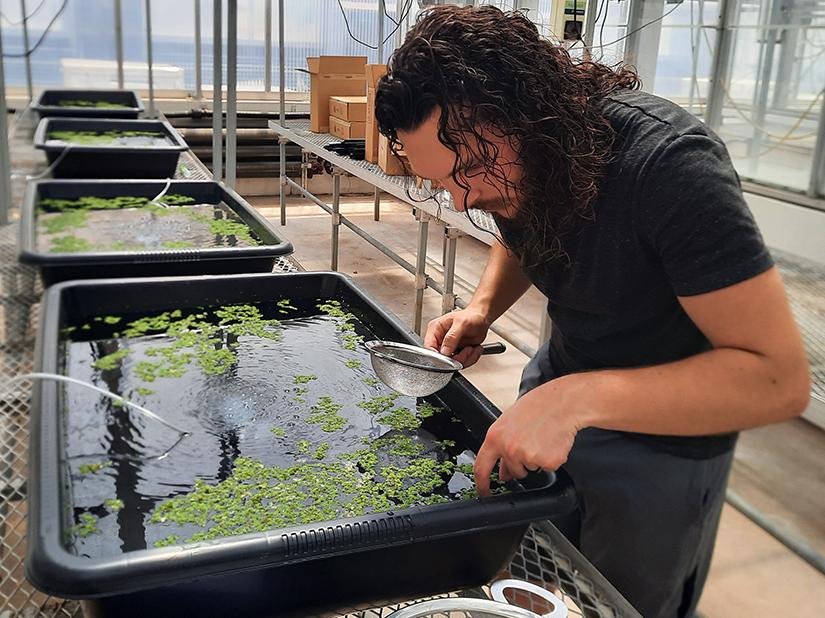Friday, 12 September 2025
Common plants could help reduce food insecurity, researchers find
The researchers found that the Carolina strain of Azolla is more digestible and nutritious for humans than Azolla varieties that grow in the wild and also are cultivated in Asia…

The researchers found that the Carolina strain of Azolla is more digestible and nutritious for humans than Azolla varieties that grow in the wild and also are cultivated in Asia and Africa for livestock feed
An often-overlooked water plant that can double its biomass in two days, capture nitrogen from the air — making it a valuable green fertiliser — and be fed to poultry and livestock could serve as life-saving food for humans in the event of a catastrophe or disaster, a new study led by Penn State researchers suggests.
Native to the eastern U.S., the plant, Azolla caroliniana Willd — commonly known as Carolina Azolla — also could ease food insecurity shortly, according to findings recently published in Food Science & Nutrition. The researchers found that the Carolina strain of Azolla is more digestible and nutritious for humans than Azolla varieties that grow in the wild and also are cultivated in Asia and Africa for livestock feed.
The study, which was led by Daniel Winstead, a research assistant in the labs of Michael Jacobson, professor of ecosystem science and management, and Francesco Di Gioia, assistant professor of vegetable crop science, is part of a larger interdisciplinary research project called Food Resilience in the Face of Catastrophic Global Events conducted in the College of Agricultural Sciences.
In the study, Carolina azolla — which has been described as having a crisp texture and a neutral taste — was grown in a greenhouse located at Penn State’s University Park campus. The researchers determined that Carolina Azolla has a total phenolic content of about 4.26 grams, gallic acid equivalents per kilogram dry weight.
This measurement compares with fruits, Winstead pointed out, which generally are between 1.4 and 6.2; beans at 1.2 to 6.6; and nuts, ranging from 0.5 to 19. By comparison, he added, other species of Azolla that grow in Asia and Africa are between 20 and 69 grams, of gallic acid equivalents per kilogram dry weight — too high for humans to digest comfortably.
The researchers tested three cooking methods — boiling, pressure cooking and natural fermentation — that multiple studies have shown can decrease polyphenolic content in foods, to reduce antinutritional factors potentially restricting the consumption of azolla by both humans and livestock. Tests showed total phenol content was reduced by 88 per cent, 92 per cent and 62 per cent with boiling, pressure cooking and natural fermentation, respectively, compared to the raw plant.
Carolina Azolla — sometimes referred to as mosquito fern, fairy moss and water fern — holds excellent potential for use as a fast-growing, short-season crop that requires minimal inputs, upkeep and processing, Winstead noted, adding that the plant could be used to increase the food supply.
Technology
Tetra Pak and Swan Neck Bio collaborate to simplify scaling of new food
Sep 11, 2025 | Company News
BASF launches world’s first thermoplastic polyamide
Sep 11, 2025 | Company News
Edacious and RAO enter collaboration to measure nutritional impact of regenerative organic certified agriculture
Sep 11, 2025 | Company News
Food Testing
Tetra Pak and Swan Neck Bio collaborate to simplify scaling of new food
Sep 11, 2025 | Company News
Edacious and RAO enter collaboration to measure nutritional impact of regenerative organic certified agriculture
Sep 11, 2025 | Company News
Illness to Wellness Foundation and PEFI launches ‘Swasth Haath, Swasth Bachpan’ campaign
Sep 09, 2025 | Food Safety and Testing
More Popular
DKSH strengthens ties with Suntory to drive beverage and wellness growth in Asia
Sep 12, 2025 | Beverages
Australia Essence brings authentic Australian premium brands to India
Sep 12, 2025 | Australia
Study shows Palatinose enhances response of gut hormones GLP-1 and PYY
Sep 12, 2025 | Food




